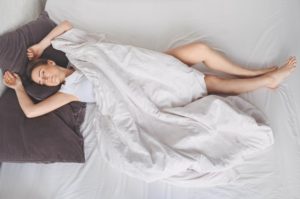Restless legs syndrome (RLS) is a disorder that cause a strong urge to move. It also causes sensations described as creeping, itching, pulling, crawling, tugging, throbbing, burning, or gnawing. RLS runs in families and is also associated with many conditions and diseases.
These sensations usually occur when lying down in bed or when sitting for long periods of time, such as while driving or while at a theater. RLS typically occurs in the evening, making it difficult to fall asleep. Often times people with RLS want to walk around and shake their legs (or arms) to help relieve the uncomfortable sensations.

Restless leg syndrome
Causes
RLS has been found to be a genetic syndrome in some cases, meaning that parents with RLS can pass it down to their children. Up to 92% of patients with RLS have a first-degree relative with the disorder. These patients tend to develop symptoms earlier in life (before age 45) than those with RLS without the genetic link.
In addition to the genetic source, many medical problems are closely associated with the development of RLS, including:
- Low levels of iron (iron deficiency).
- Uremia (a condition associated with worsening kidney function).
- Hypothyroidism.
- Depression.
- Fibromyalgia.
- Parkinson’s disease.
- Kidney disease.
- Diabetes.
- Rheumatoid arthritis.
- Peripheral neuropathy.
- Pregnancy.
- Dialysis.
Symptoms
- Leg (or arm) discomfort: These uncomfortable limb sensations are often described by adults as creeping, itching, pulling, crawling, tugging, throbbing, burning, or gnawing. These sensations usually occur at bedtime but can occur at other times of limb inactivity.
- Urge to move legs (or arms): To relieve limb discomfort, you have an uncontrollable urge to move your limbs especially when resting, such as when sitting or lying down.
- Sleep disruption: Additional time is often needed to fall asleep because of the urge to move your limbs to relieve the discomfort. Sometimes staying asleep may also be difficult.
- Bedtime behavior problems: Because of the discomfort, you may need to get out of bed to stretch your limbs to relieve the discomfort.
- Daytime sleepiness: Problems with falling asleep and staying asleep may result in daytime sleepiness.
- Behavior and work performance problems: Again, due to sleep disruption, problems may emerge in daytime behavior (irritability, moodiness, difficulty concentrating, hyperactivity, etc) and work performance.
Treatments
- Getting regular exercise, such as riding a bike/stationary bike or walking, but avoiding heavy/intense exercise within a few hours of bedtime.
- Following good sleep habits, including avoiding reading, watching television or being on a computer or phone while lying in bed; getting 7 to 9 hours of sleep and following other healthy sleep habits. Not getting enough sleep can worsen RLS symptoms.
- Avoiding or limiting caffeinated products (coffees, teas, colas, chocolates, and some medications [check labels]), nicotine, and alcohol.
- Applying a heating pad, cold compress, or rubbing your legs to provide temporary relief to the leg discomfort. Also consider massage, acupressure, walking, light stretching or other relaxation techniques.
- Soak in a warm tub.
- Try magnesium supplements: They may be helpful.
- Reduce stress as much as possible: Try meditation, yoga, soft music or other options.
- Iron supplementation: Iron deficiency is a reversible cause of RLS. If blood tests reveal you have low iron levels, your doctor may recommend taking an iron supplement.
